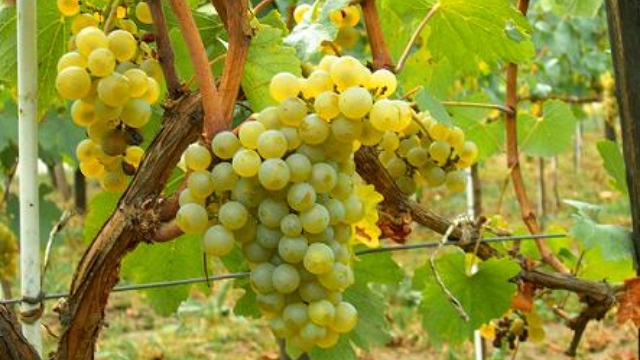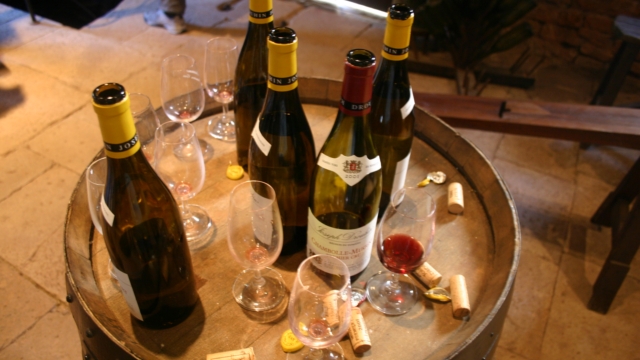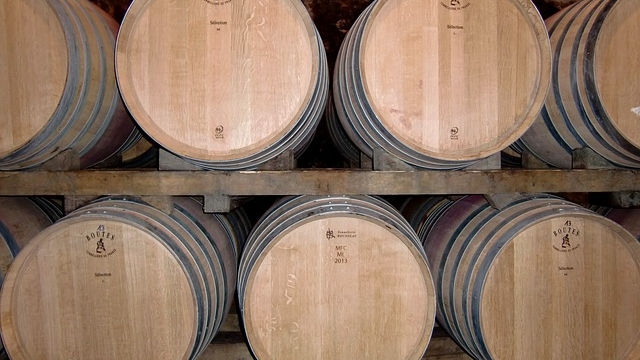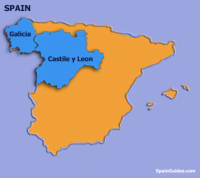That Useful Wine Site
Search, or just roll your cursor over the colored boxes farther below.click the “x” to dismiss Search-results block.




Advertisement:
Advertisement:
Quick page jumps:
(Synonyms: Dão, Jaen, Jaen du Dão, Loureiro Tinto, Mencía Pajaral)

Mencía is a red-wine grape originating in Spain, where it is today grown primarily in the appellations of Bierzo, Ribeira Sacra, and Valdeorras, which lie in the regions of Castile y Leon and Galicia. It was formerly a relatively minor varietal, but over the past two decades has emerged into notably greater popularity.
In older days, Mencía was usually made as a light-bodied, light-colored, aromatic (and often somewhat astringent) red for early consumption—a sort of Spanish Beaujolais. More recently (as with many grapes) its potential for greater things has been recognized, and significantly deeper, richer, more complex versions are being made, with old-vine bottlings leading the way.
Descriptions of the better Mencías of today are typical of any good red: dark fruit (black cherry, raspberry, blackberry), herbs, earthiness. Remember, it was long confused with Cab Franc, so there is another guideline. But if those sound generic, be assured that most tasters find Mencia distinctive and clearly varietal; as one winemaker put it, “the world didn’t need another claret.“
Factoid: Mencía is apparently the same grape as Portugal’s Jaen. It is not at all related to Cabernet Franc, though such a relation was long suspected owing to similarities of aromas.
Mencia is another fine but seriously under-appreciated Spanish red. There are some nice bargains out there.
• This wine’s Wine Searcher “Reviews” page.
• This wine’s CellarTracker review pages.
• Retail offers of this wine listed by Wine Searcher.
• Retail offers of this wine listed by 1000 Corks.
• This wine’s Wine Searcher “Reviews” page.
• This wine’s CellarTracker review pages.
• Retail offers of this wine listed by Wine Searcher.
• Retail offers of this wine listed by 1000 Corks.
• This wine’s Wine Searcher “Reviews” page.
• This wine’s CellarTracker review pages.
• Retail offers of this wine listed by Wine Searcher.
• Retail offers of this wine listed by 1000 Corks.
• This wine’s Wine Searcher “Reviews” page.
• This wine’s CellarTracker review pages.
• Retail offers of this wine listed by Wine Searcher.
• Retail offers of this wine listed by 1000 Corks.
• This wine’s Wine Searcher “Reviews” page.
• This wine’s CellarTracker review pages.
• Retail offers of this wine listed by Wine Searcher.
• Retail offers of this wine listed by 1000 Corks.
Our nomination is the Raul Pérez Rapolao “Ultreia” which retails at about $35 to $90.
• This wine’s Wine Searcher “Reviews” page.
• This wine’s CellarTracker review pages.
• Retail offers of this wine listed by Wine Searcher.
• Retail offers of this wine listed by 1000 Corks.
Advertisement:
Advertisement:
|
|
This site is one of The Owlcroft Company family of web sites. Please click on the link (or the owl) to see a menu of our other diverse user-friendly, helpful sites. |
|
| (Note: All Owlcroft systems run on Ubuntu Linux and we heartily recommend it to everyone—click on the link for more information). | ||
|
All content copyright © 2024 The Owlcroft Company
(excepting quoted material, which is believed to be Fair Use). |
This web page is strictly compliant with the W3C (World Wide Web Consortium) Extensible HyperText Markup Language (XHTML) Protocol v1.0 (Transitional) and the W3C Cascading Style Sheets (CSS) Protocol v3 — because we care about interoperability. Click on the logos below to test us!
This page was last modified on Monday, 8 November 2021, at 10:21 am Pacific Time.
Some Descriptions of Mencía Wines
“Most wines produced from Mencía have traditionally been light, pale, relatively fragrant red wines for early consumption. This style of wine was the result of post-Phylloxera plantations on fertile plains, which tended to give high yields but diluted wine. In recent years, much more concentrated and complex wines have been produced by a new generation of winemakers, primarily from old vines growing on hillsides, often on schist soils, in combination with careful vineyard management. This has led to a renewed interest in Mencía and the Denominaciones de Origen using it, such as Bierzo, Valdeorras, Ribeira Sacra and the little-known Liébana.”
“It is an aromatic variety, with a bouquet of crushed raspberries and cherries – similar to cabernet franc. It has a medium bodied palate with lots of natural acidity, which reminds me of pinot noir to taste – but it is much, much more minerally than a pinot with steelier tannins. One retailer describes his mencia as having ‘sapid mouthwatering ink/blood notes’ – I can see what he means. Two styles of mencia exist in Bierzo. The highest vineyard slopes have granite and schist soils which produce a more minerally style, while the lower alluvial clay and stone valleys along the river Sil produce an earthier, riper, style.”
“We were enchanted with the haunting, complex aromas of the mencía grape, which is used to such wonderful effect only in northwest Spain.…Tasting through 25 bottles of Bierzo, we found some wines that offer the mencía largely unadorned, in all its exotic fruit, wildflower and mineral glory. These wines tend to be light-bodied and refreshing. Others we found to have benefited from aging in oak barrels and other modern winemaking techniques, which gave the wines structure and intensity without tasting overtly oaky or compromising their Bierzo integrity. And yes, we did find some wines that seemed too far from home, having lost any sense of regional identity.”
“[Mencía is] fruity, aromatic, and a bit higher in acidity than [Tempranillo and Garnacha]. In the lesser vineyards, that means fruity, often simple wines, but when vineyard conditions promote greater concentration and structure, some really exciting wines can result. Plum, cherry, and spice (more pipe tobacco or cocoa than pepper) aromas are typical, sometimes supported by meaty or mineral touches. More powerful examples often show a trace of licorice as well. Most producers have held back on new French oak, which is in keeping with the grape’s lift of acidity and relatively mild tannins. The temptation to apply more oak does come into play with more expensive bottling (most producers here make wines at several price points), so often the cheaper wines capture the grape’s character more clearly than the flagship wines. Find the price-to-style ratio that works best for you and your guests.”
“Mencia is a ‘hot’ grape right now in Spain, especially as it is a indigenous varietal. Characteristics of the grape are said to be a deep purple/maroon with some transparency, and a medium + nose of deep concentrated black fruit (especially black cherry), mint, and wild herbs like sage.”
“Spicy with rose petals, black pepper, roasted red peppers and berrylike fruit, mencia has always reminded me a little bit of garnacha and cabernet franc — until recently it was thought to be related to, if not a carbon copy of, the latter.…With the grape having been grown in Spain for centuries, there exist several old vineyards, some which were planted in the 19th century. It is found in Bierzo, the most western appellation of Castilla y Leon, and throughout Galicia. In the latter, it tends to do best in the continental climates of Monterrei, Ribeira Sacra and Valdeorras, which are marked by cold winters and long, hot summers.”
“Mencía has only recently come into spotlight as a quality, potential-laden grape variety. When properly made, it offers fascinating wines across a contrasting spectrum of styles; on the one end are fruity and forward wines with supple tannins and succulent fruit. On the other end are more concentrated, powerful styles with an exotic earthiness, smooth tannins and an enviable reflection of the minerally-rich Bierzo terroir. Mencía is capable of making excellent wine on its own, with no need to sacrifice its unique character in blends with Cabernet Sauvignon or Merlot that are commonplace elsewhere in Spain.”
“Mencia defines Bierzo, and its signature is hard to miss - a nose filled with primal, sometimes fierce aromas. Blood is a scent in wine I don't usually discuss in public (try explaining that one in polite company), but Bierzo wines can smell beautifully sanguine, in addition to floral, spicy, animal scents and powerful mineral presence. These are not qualities to charm all, but then neither are the peppery tones of Syrah.…My recent tasting of about 15 Bierzo wines made clear how wide the styles swing. Young, they offered the vibrancy of good Beaujolais; the oak-aged wines were more stylish but most retained some nuance. It’s hard to find bad Bierzo, a credit to the young enologists working in the region.”
“[Mencia] Wines today are more likely to have a bright complexion with a vivid maroon color, fresh acidity and tannins, and dark-fruit flavors with a herbal dimension of mint or thyme. Some producers are experimenting with carbonic maceration to accentuate the variety’s fruit characteristics and reduce tannins, and wines made using this method are more approachable in their youth.”
“Fortunately, these winemakers have wised up, and with a bit of patience and new technology, they are finding that the ‘potential’ was not that hard to access after all. Better crop management, temperature controlled fermentation and more experimentation with oak barrels have all led to exciting results. What has emerged are wines that can be powerful, while nuanced with red fruits and earthy richness. In fact, they tend to be some of the more interesting wines in my opinion landing on Spanish wine shelves. Often the color will be a deep maroon, though I have found good examples that tend to be on the lighter side as well. Typical flavors are of earth, herbs (think mint, rosemary, thyme), dark fruits (raspberry, black cherry, blackberry) and I often find black pepper coming to the fore front as well.”
“But, that’s all changing rapidly … nothing at all cabernet-like about it when well handled: you’re more likely to see something that looks like a cross between Cornas (wild, spicey northern Rhone syrah) and funky top-end Burgundy. An absolute feature is a long, fine, extremely silky thread of fruit tannin all the way down the palate.”
“I’ll never forget my first experience of a red wine made from the grape mencia grown in an area in northwestern Spain called Bierzo, both new to me. Something special marked this wine’s aroma, how its several layers of scent jumped from the glass, like many-colored Buddhist prayer flags fluttering in the wind. Aromas of both red and blue fruits were there, but also more, the smell of wet black stone, slate stone particularly, and a kind of ‘wine-iness’, a grape-y sapidity to which I hadn’t paid much attention in red wine before. Beautiful color, too, a brilliant red sparked with magenta at its edge; and a mouthful of flavors that those same aromas had presaged, made liquid, juicy in texture, with a refreshing tang as a finish. ‘Juicy’ is the best summary word.”